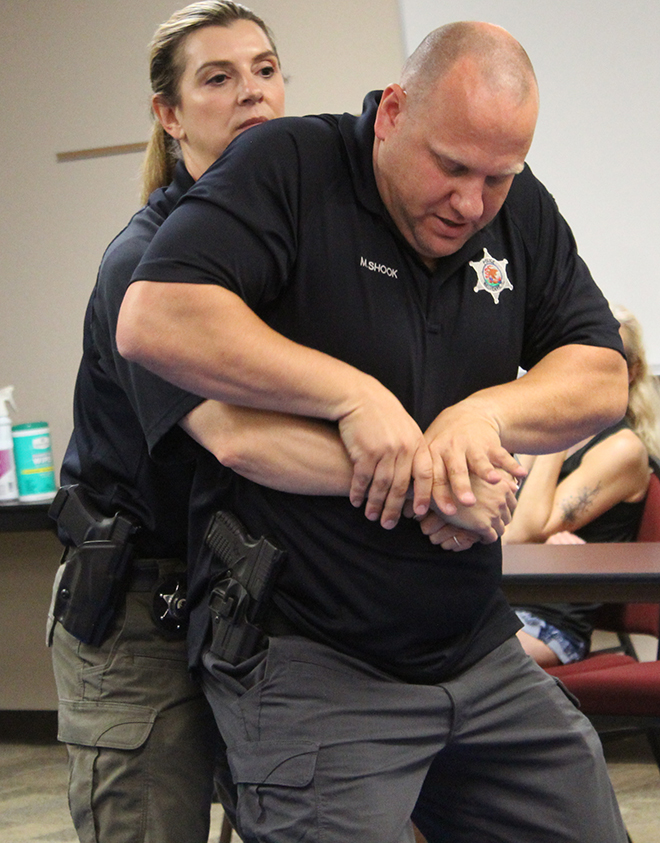BPD presents a self-defense class

ANNE EICKSTADT PHOTO Belvidere Republican
Officer Shook demonstrates how to escape when an attacker has grabbed you from behind.
On Saturday, July 30, the Belvidere Police Department held a women’s self-defense class because so many people are concerned for their safety. Society expects certain things from women. Self-defense needs a different type of behavior. Officer Matt Shook led the class with the able assistance of Officer Michelle Schwartz.
Shook started off the two-hour class with a fairly brief lecture on what the rules are according to the law regarding self-defense. As far as the law is concerned self-defense is your right to protect yourself (or someone else) from harm by using a sufficient amount of counteracting force. Different states have different rules in regards to when self-defense applies and to the level of force that is acceptable. But, as a general rule, here’s when self-defense is permissible by law:
Self-defense is only applicable when it is a reaction to an immediate threat. If you are attacked or a verbal threat is made that leaves you in fear of physical harm, then you can use just force. It’s important to note that if you defend yourself and the attacker stops the attack, then so does the imminent threat. Any force used after the attack has ended would not be considered self-defense.
Self-defense is justified when the force used in self-defense matches the perceived threat. If some attacks you with a knife, then deadly force would probably be viewed as a proportional response. However, if you were to respond to a minor threat with potentially lethal force then the argument of self-defense might not be valid. Self-defense can be used to defend yourself or someone else.
If there is the commission of a serious crime/felony, you can use deadly force.
Statistics show that a woman is raped every 46 seconds. Fifty-five to 75 percent of the time, drugs or alcohol are involved. Also, 90 percent of the time, studies show that the attacker will usually be someone the victim knows. Shook says to be aware of your surroundings, that situational awareness is important at all times. He mentioned that Jeff Cooper wrote extensively about firearms and personal protection; he always stressed the importance of taking a practical approach. He emphasized that weaponry and fighting skills are less important in surviving a lethal confrontation than having a combat mindset. While he never claimed to have created the color code of situational awareness, he is credited with being the first person to have written on the subject. Cooper used the color code to describe one’s state of mind as it relates to one’s degree of danger and their willingness to act. As taught by Cooper, the color code includes mental states of White, Yellow, Orange and Red. The following description of each state is from “The Carry Book: Minnesota Edition:”
White: Unaware and unprepared. If attacked in Condition White, the only thing that may save you is the inadequacy or ineptitude of your attacker. When confronted by something nasty, your reaction will probably be “Oh my God! This can’t be happening to me.”
Yellow: Relaxed alert. No specific threat situation. Your mindset is that “today could be the day I may have to defend myself”. You are simply aware that the world is a potentially unfriendly place and that you are prepared to defend yourself, if necessary. You use your eyes and ears and realize that “I may have to shoot today”. You don’t have to be armed in this state, but if you are armed you should be in Condition Yellow. You should always be in Yellow whenever you are in unfamiliar surroundings or among people you don’t know. You can remain in Yellow for long periods, as long as you are able to “Watch your six.” (In aviation 12 o’clock refers to the direction in front of the aircraft’s nose. Six o’clock is the blind spot behind the pilot.) In Yellow, you are “taking in” surrounding information in a relaxed but alert manner, like a continuous 360-degree radar sweep. As Cooper put it, “I might have to shoot.”
Orange: Specific alert. Something is not quite right and has your attention. Your radar has picked up a specific alert. You shift your primary focus to determine if there is a threat (but you do not drop your six). Your mindset shifts to “I may have to shoot that person today”, focusing on the specific target which has caused the escalation in alert status. In Condition Orange, you set a mental trigger: “If that person does “X”, I will need to stop them”. Your pistol usually remains holstered in this state. Staying in Orange can be a bit of a mental strain, but you can stay in it for as long as you need to. If the threat proves to be nothing, you shift back to Condition Yellow.
Red: Condition Red is fight. Your mental trigger (established back in Condition Orange) has been tripped. “If ‘X’ happens I will shoot that person” — ‘X’ has happened, the fight is on.
Cooper’s color code has been discussed and written about extensively. It has become dogma in the personal defense community that it is a great truth that people should live their life in Condition Yellow.
Shook and Schwartz demonstrated a number of self-defense moves to use when attacked and answered questions from the women in attendance. Then, it came time for the class to practice striking pads and, finally, to use everything they had learned to defend themselves against an offender as portrayed by Shook.
He emphasized the importance of your mindset to defend yourself, situational awareness, and where to find more extensive training in this area. Your body does not know how to respond when you have never been in that situation before.
Keep an eye on the Belvidere Police Department Facebook page to learn when the next self-defense class will be held.


